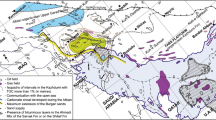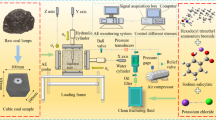Abstract
The slurry infiltration process contributes significantly to the stability of tunnelling face during the application of slurry pressure balanced tunnel boring machine (SPB TBM) in construction. A coupled computational fluid dynamics and discrete element method (CFD-DEM) model is developed to simulate the formation and long-term impermeable stability of filter cake considering different infiltration conditions, e.g., the cohesiveness of bentonite slurry and the permeability of sandy ground. The morphology of formed filter cakes and the pressure drops are analysed macroscopically. Then, the long-term impermeable stability of filter cakes under increasing slurry pressure is evaluated based on the evolution of the pressure gradient magnitude along the infiltration direction; additionally, the contact and force fabrics of filter cakes are examined to investigate their failure process from the micro-mechanical aspect. The numerical results indicate that the increase of size ratio of sand to slurry particle and the slurry cohesion restrain and enhance, respectively, the formation of filter cakes and their long-term permeable and mechanical stability subjected to dynamic hydraulic loads. This work contributes to the further development of the phenomenological model and the micromechanical constitutive model of slurry infiltration involving multifield and multiphase media.


















Similar content being viewed by others
Data availability
The data that support the findings of this study are available from the corresponding author upon request.
References
Anagnostou G, Kovári K (1994) The face stability of slurry-shield-driven tunnels. Tunn Undergr Space Technol 9(2):165–174
Bezuijen A (2008) Processes around a TBM. pp 3–13
Bezuijen A (2021) Pore pressures in front of a slurry TBM, the influence of plastering mechanisms, 1st edn. CRC Press, Boca Raton
Bezuijen A, Sanders MPM, Den Hamer D (2009) Parameters that influence the pressure filtration characteristics of bentonite grouts. Geotechnique 59(8):717–721
Bezuijen A, Steeneken S, Ruigrok J (2016) Monitoring and analysing pressures around a TBM. In: Proceeding 13th international conference underground construction 1, pp 1–9
Broere W (2016) Urban underground space: solving the problems of today’s cities. Tunn Undergr Space Technol 55:245–248
Hong C, Luo G, Chen W (2022a) Safety analysis of a deep foundation ditch using deep learning methods. Gondwana Res
Hong C, Yang Q, Sun X, Chen W, Han K (2021) A theoretical strain transfer model between optical fiber sensors and monitored substrates. Geotext Geomembr 49:1539–1549
Hong C, Wang X, Han K, Su D, Chen Z (2022) Performance investigation of 3d printed clay soil using fiber bragg grating technology. Acta Geotechnica 17:453–462
Chen F, Xiong H, Wang X, Yin Z-Y (2023) Transmission effect of eroded particles in suffusion using the CFD-DEM coupling method. Acta Geotech 18:335–354
Cui W, Liu D, Song H-F, Pu G-J (2019) Development and experimental study on environmental slurry for slurry shield tunneling. Constr Build Mater 216:416–423
Ergun S (1952) Fluid flow through packed columns. J Mater Sci Chem Eng 48(2):89–94
Feng X, Liu T, Wang L, Yu Y, Zhang S, Song L (2021) Investigation on JKR surface energy of high-humidity maize grains. Powder Technol 382:406–419
Fritz P (2007) Additives for slurry shields in highly permeable ground. Rock Mech Rock Eng 40(1):81–95
Gera D, Gautam M, Tsuji Y, Kawaguchi T, Tanaka T (1998) Computer simulation of bubbles in large-particle fluidized beds. Powder Technol 98(1):38–47
Guo Y, Yang Y, Yu X (2018) Influence of particle shape on the erodibility of non-cohesive soil: insights from coupled CFD-DEM simulations. Particuology 39:12–24
Han Y (2012) Construction of a IBM-DEM coupling system and its applications in modeling fluid particle interaction in porous media flow. Ph.D. thesis, University of Minnesota
Helland E, Bournot H, Occelli R, Tadrist L (2007) Drag reduction and cluster formation in a circulating fluidised bed. Chem Eng Sci 62(1):148–158
Hu Z, Zhang Y, Yang Z (2019) Suffusion-induced deformation and microstructural change of granular soils: a coupled CFD-DEM study. Acta Geotech 14(3):795–814
Huilin L, Gidaspow D (2003) Hydrodynamics of binary fluidization in a riser: CFD simulation using two granular temperatures. Chem Eng Sci 58(16):3777–3792
Huilin L, Guodong L, Shuai W, Wenhao Y (2015) Structure-dependent drag model for simulation of gas-solids fluidized beds, vol 7
Johnson KL (1985) Contact mechanics, 1st edn. Cambridge University Press, Cambridge
Kloss C, Goniva C, Hager A, Amberger S, Pirker S (2012) Models, algorithms and validation for opensource dem and CFD-DEM. Prog Computc Fluid Dyn 12(2–3):140–152
Li WC, Deng G, Liang XQ, Sun XX, Wang SW, Lee ML (2020) Effects of stress state and fine fraction on stress transmission in internally unstable granular mixtures investigated via discrete element method. Powder Technol 367:659–670
Lu H, Gidaspow D, Bouillard J, Liu W (2003) Hydrodynamic simulation of gas-solid flow in a riser using kinetic theory of granular flow. Chem Eng J 95(1):1–13
Lu Z, Zhou W-H, Yin Z-Y, Yang J (2022) Numerical modeling of viscous slurry infiltration in sand. Comput Geotech 146:104745
Ma Q, Wautier A, Zhou W (2021) Microscopic mechanism of particle detachment in granular materials subjected to suffusion in anisotropic stress states. Acta Geotech 16(8):2575–2591
Min F, Du J, Zhang N, Chen X, Lv H, Liu L, Yu C (2019) Experimental study on property change of slurry and filter cake of slurry shield under seawater intrusion. Tunn Undergr Space Technol 88:290–299
Min F, Zhu W, Han X (2013) Filter cake formation for slurry shield tunneling in highly permeable sand. Tunn Undergr Space Technol 38:423–430
Nicot F, Hadda N, Guessasma M, Fortin J, Millet O (2013) On the definition of the stress tensor in granular media. Int J Solids Struct 50(14–15):2508–2517
O’Rorke RD, Steele TWJ, Taylor HK (2016) Bioinspired fibrillar adhesives: a review of analytical models and experimental evidence for adhesion enhancement by surface patterns. J Adhes Sci Technol 30(4):362–391
Peng Z, Doroodchi E, Luo C, Moghtaderi B (2014) Influence of void fraction calculation on fidelity of CFD-DEM simulation of gas-solid bubbling fluidized beds. AIChE J 60(6):2000–2018
Sato M, Kuwano R (2015) Suffusion and clogging by one-dimensional seepage tests on cohesive soil. Soils Found 55(6):1427–1440
Shire T, O’Sullivan C, Hanley KJ (2016) The influence of fines content and size-ratio on the micro-scale properties of dense bimodal materials. Granular Matter 18(3):1–10
Shire T, O’Sullivan C, Hanley KJ, Fannin RJ (2014) Fabric and effective stress distribution in internally unstable soils. J Geotech Geoenviron Eng 140(12):04014072
Talmon AM, Mastbergen DR, Huisman M (2013) Invasion of pressurized clay suspensions into granular soil. J Porous Media 16(4):351–365
Tran D, Prime N, Froiio F, Callari C, Vincens E (2017) Numerical modelling of backward front propagation in piping erosion by DEM-IBM coupling. Eur J Environ Civ Eng 21(7–8):960–987
Upadhyay M, Kim A, Kim H, Lim D, Lim H (2020) An assessment of drag models in eulerian-eulerian CFD simulation of gas-solid flow hydrodynamics in circulating fluidized bed riser. ChemEngineering 4(2):37
Valdes JR, Santamarina JC (2008) Clogging: bridge formation and vibration-based destabilization. Can Geotech J 45(2):177–184
Wang D, Wang B, Jiang Q, Guo N, Zhang W, He K (2022) Large deformation slope failure - a perspective from multiscale modelling. Comput Geotech 150:104886
Wang X, Tang Y, Huang B, Hu T, Ling D (2021) Review on numerical simulation of the internal soil erosion mechanisms using the discrete element method. Water 13(2):169
Wautier A, Bonelli S, Nicot F (2018) Flow impact on granular force chains and induced instability. Phys Rev E 98(4):042909
Wen CY, Yu YH (1966) Mechanics of fluidization. Chem Eng Prog Symp Series 62:100–111
Xiong H, Wu H, Bao X, Fei J (2021) Investigating effect of particle shape on suffusion by CFD-DEM modeling. Constr Build Mater 289:123043
Xiong H, Yin Z-Y, Nicot F (2020) Programming a micro-mechanical model of granular materials in Julia. Adv Eng Softw 145:102816
Xiong H, Yin Z-Y, Nicot F, Wautier A, Marie M, Darve F, Veylon G, Philippe P (2021) A novel multi-scale large deformation approach for modelling of granular collapse. Acta Geotech 16:2371–2388
Xiong H, Yin Z-Y, Zhao J, Yang Y (2021) Investigating the effect of flow direction on suffusion and its impacts on gap-graded granular soils. Acta Geotech 16(2):399–419
Xiong H, Zhang Z, Sun X, Yu Yin Z, Chen X (2022) Clogging effect of fines in seepage erosion by using CFD-DEM. Comput Geotech 152:105013
Xu T, Bezuijen A (2018) Analytical methods in predicting excess pore water pressure in front of slurry shield in saturated sandy ground. Tunn Undergr Space Technol 73:203–211
Xu T, Bezuijen A (2019) Bentonite slurry infiltration into sand: filter cake formation under various conditions. Geotechnique 69:1095–1106
Xu T, Bezuijen A (2019) Experimental study on the mechanisms of bentonite slurry penetration in front of a slurry TBM. Tunn Undergr Space Technol 93:103052
Xu T, Bezuijen A (2019) Pressure infiltration characteristics of bentonite slurry. Geotechnique 69(4):364–368
Yin T, Zhang Z, Huang X, Shire T, Hanley KJ (2021) On the morphology and pressure-filtration characteristics of filter cake formation: insight from coupled CFD–DEM simulations. Tunn Undergr Space Technol 111:103856
Yin X-S, Chen R-P, Li Y-C, Qi S (2016) A column system for modeling bentonite slurry infiltration in sands. J Zhejiang Univ Sci A 17(10):818–827
Yoon J, El Mohtar C (2013) Groutability of granular soils using sodium pyrophosphate modified bentonite suspensions. Tunn Undergr Space Technol 37:135–145
Yoon J, El Mohtar CS (2015) A filtration model for evaluating maximum penetration distance of bentonite grout through granular soils. Comput Geotech 65:291–301
Zhang F, Wang T, Liu F, Peng M, Furtney J, Zhang L (2020) Modeling of fluid-particle interaction by coupling the discrete element method with a dynamic fluid mesh: implications to suffusion in gap-graded soils. Comput Geotech 124:103617
Zhang Z, Yin T, Huang X, Dias D (2019) Slurry filtration process and filter cake formation during shield tunnelling: Insight from coupled CFD-DEM simulations of slurry filtration column test. Tunn Undergr Space Technol 87:64–77
Zhou W, Wu W, Ma G, Ng T-T, Chang X (2018) Undrained behavior of binary granular mixtures with different fines contents. Powder Technol 340:139–153
Zhuang XY, Zhang ZX, Huang X, Yin T (2020) Slurry infiltration column tests on saturated sand. IOP Conf Series: Earth Environ Sci 570(3):032061
Acknowledgements
This study was financially supported by the National Natural Science Foundation of China (Project No. 52090084, No. 52208354, and No. 51938008).
Author information
Authors and Affiliations
Corresponding author
Ethics declarations
Conflict of interest
None.
Additional information
Publisher's Note
Springer Nature remains neutral with regard to jurisdictional claims in published maps and institutional affiliations.
Rights and permissions
Springer Nature or its licensor (e.g. a society or other partner) holds exclusive rights to this article under a publishing agreement with the author(s) or other rightsholder(s); author self-archiving of the accepted manuscript version of this article is solely governed by the terms of such publishing agreement and applicable law.
About this article
Cite this article
Chen, F., Xiong, H., Yin, ZY. et al. Impermeable and mechanical stability of filter cake under different infiltration conditions via CFD-DEM. Acta Geotech. 18, 4115–4140 (2023). https://doi.org/10.1007/s11440-023-01805-8
Received:
Accepted:
Published:
Issue Date:
DOI: https://doi.org/10.1007/s11440-023-01805-8




